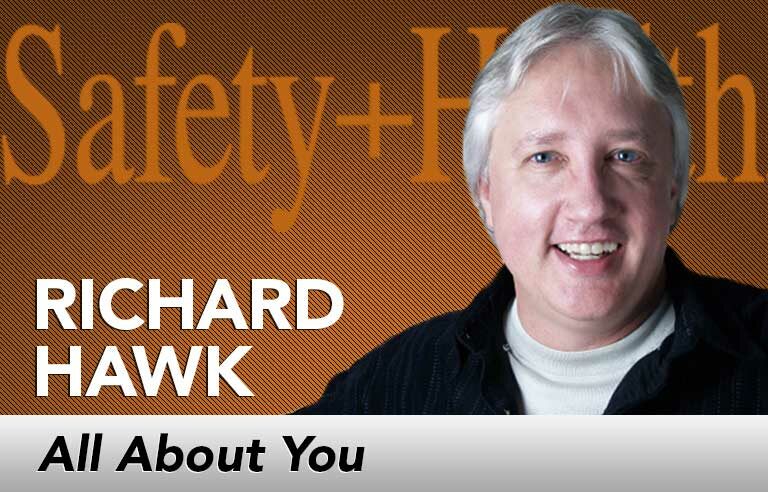All About You: 'Mindful meditation'

EDITOR’S NOTE: Motivating employees to work safely is part of the safety professional’s job. But who motivates the motivator? In this monthly column, veteran safety pro and professional speaker Richard Hawk offers his entertaining brand of wisdom to inspire safety pros to perform at their best.
When you are at rest, you take nearly 1,000 breaths per hour. This life-essential activity is usually done involuntarily, which means unless you’re having trouble breathing, most times you don’t notice it. You can change that, of course. With little effort you can put breathing under your conscious control. You can speed up and deepen your respiration or make it shallow. You can even stop it for a bit. (What you can’t do is not breathe for any longer than a moment or two, because your life is dependent on a regular flow of oxygen.) You also can simply pay attention to your breathing without changing it, which I have found (and so has much modern research) can help you feel better both physically and mentally.
It’s called “mindful meditation” and its popularity is skyrocketing as a tool to help people better handle negative emotions, reduce the impact of psychological problems and learn to enjoy life more. I know it works for me. What I particularly like about it is that it’s simple and you can do it at just about any time.
All sorts of organizations and groups are using mindful mediation as part of their health and performance programs, including the military, police and fire departments, hospitals, schools, professional sports teams, and even Congress. (Rep. Tim Ryan hosts mindful meditation sessions on Capitol Hill.)
Why does it work?
If you learned to play the guitar, it wouldn’t be long before your brain would change its “wiring.” If you practiced long enough, you’d be able to see the changes using an fMRI. Same thing goes with mindful meditation: Your brain will change in ways that help you notice your reactions, surroundings and even lessen the negative emotions that arise. (You won’t get as upset by constant complainers and safety procedure violations! You’ll be more likely to handle the situations calmly.)
Mindful meditation isn’t a cure-all for your personal problems or bad moods, but it will help you be more skillful at handling them. Research has shown that it also boosts your immune system, improves digestion and oxygen flow, and can decrease your blood pressure, making it well worth the effort.
How do you do it?
Although there are many ways to meditate mindfully, let me share with you the type I practice most.
First, I set my smartphone timer for 10 to 20 minutes. (You don’t need a timer, and often I pay attention to my breath for a moment or two throughout the day.) Next, I sit on a pillow or chair in a relaxed position, but keep my back straight and let my shoulders drop. Although you don’t have to, I usually close my eyes.
Next, I take a few deep breaths. Then I just let my breathing flow naturally. I notice how the air flows in and out of my nose and chest, as well as the up-and-down/in-and-out motion of my upper body.
When you first start meditating, no doubt you’ll stop paying attention to your breathing; maybe even right away. That’s fine. Once you realize it, go back to paying attention to your breathing again. I keep doing that until the timer goes off.
That’s it. Like any other skill, you’ll get better at “watching your breath” the more you practice it.
Certainly there is more to mindful meditation than what’s in this article. Some people even become masters at it. For me, it has been a simple way to improve my life and help me during difficult times. If you’d like to learn more about mindful meditation and the general subject of mindfulness, here is a superb book: “Fully Present: The Science, Art, and Practice of Mindfulness” by Susan L. Smalley and Diana Winston, directors of UCLA’s Mindful Awareness Research Center.
Why not give mindful meditation a try? You can do it just about anywhere. And there’s no doubt that you will already be breathing before you start!
 Richard Hawk helps companies around the world create more vibrant safety cultures by showing them how to make safety fun. As a professional speaker, author and musician, he also inspires employees to focus better and enlightens safety leaders about ways to increase their influence. To learn more about Richard, visit www.makesafetyfun.com.
Richard Hawk helps companies around the world create more vibrant safety cultures by showing them how to make safety fun. As a professional speaker, author and musician, he also inspires employees to focus better and enlightens safety leaders about ways to increase their influence. To learn more about Richard, visit www.makesafetyfun.com.
Subscribe to the podcast feed in iTunes
Post a comment to this article
Safety+Health welcomes comments that promote respectful dialogue. Please stay on topic. Comments that contain personal attacks, profanity or abusive language – or those aggressively promoting products or services – will be removed. We reserve the right to determine which comments violate our comment policy. (Anonymous comments are welcome; merely skip the “name” field in the comment box. An email address is required but will not be included with your comment.)

